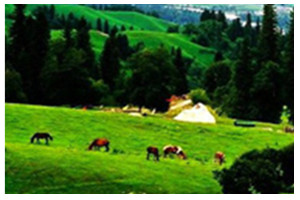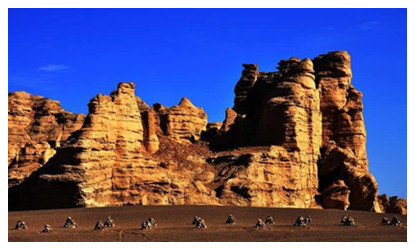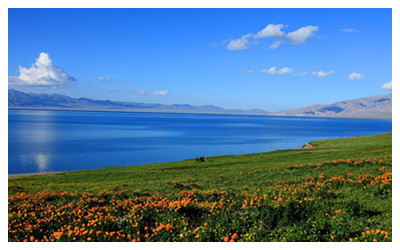Skype: neodalle-travel
Tel: +86 135 7447 2266
E-mail: sales@visitaroundchina.com
 Xinjiang Weather by Season
Xinjiang Weather by Season
Spring in Xinjiang
It gets warm and receives more sunshine in Spring of Xinjiang. With less rainfall and large area of desert, there are often frequent strong winds and dust storms. While on the prairies, you will find a vivifying spring: blooming flowers, green grassland and innumerable Cattle and sheep.
Summer in Xinjiang
Summer is the peak season of traveling in Xinjiang. Average temperatire waves around 25°C. It is hot in the basin and desert. On the contrary, you feel cool and comfortable in the mountainous region, such as Tianshan Mountains, Kunlun Mountains and Altai Mountains. While in Turpan where is the hottest places in China, the average temperature reaches to 40 °C.
Seasonal activities: cruising on the Heaven Lake, Sand Therapy.
 Autaumn in Xinjiang
Autaumn in Xinjiang
Autumn in Xinjiang features in relatively cool temperature and frequent winds. It is the season of fruits: grapes of Turpan, honey melons of Kumul, bergamot pear of Korla and many other Xinjiang special local fruits. One interesting thing is that an adult people eats more than 100kg fruits per year in Xinjiang at everage.
Seasonal activity:visiting the Grape Valley in Turpan.
Winter in Xinjiang
Winter is chilly and longlasting in Xinjiang especially in mountainous regions. Temperature in northern Xinjiang is higher then southern Xinjiang. In high elevation areas, it starts to snow from October.
Seasonal activity: Skiing in the Altay.
Best Time to visit Xinjiang
Situated far from the sea and encircled by high mountains, Xinjiang has a typical continental climate with a low annual rainfall, long sunshine duration and a large diurnal temperature variation. These weather conditions are favorable for sugar accumulation in fruit, so the area is richly cultivated with fruit including melons. It is famous as a 'hometown of fruit and melons'. The most well-known fruit are grapes and honeydew melon. In general, winters are very cold, springs are often windy, and summers are extremely hot here.
 The best time to visit is early autumn, when the days are long, the sky is clear, and the temperature is more bearable. Another excellent reason to visit at that time is the abundance of delicious melons and fruits, which are available then. The best time to visit Xinjiang is later May through June, September through October. Xinjiang's climate is one of the extremes. Winter (December to March) could be very cold. Spring (April and May) is not suitable for travel with possible dust and sandstorm.
The best time to visit is early autumn, when the days are long, the sky is clear, and the temperature is more bearable. Another excellent reason to visit at that time is the abundance of delicious melons and fruits, which are available then. The best time to visit Xinjiang is later May through June, September through October. Xinjiang's climate is one of the extremes. Winter (December to March) could be very cold. Spring (April and May) is not suitable for travel with possible dust and sandstorm.
An autumn trip to Kanas Lake is often sought after by photographers; A June through Auguest visit to Nalati Grassland and Buyanbulak Grassland is a great escape from hustle and bustle of city life; June, Auguest, September and October are the best time to explore the ancient middle and south silk roads along the Tarim Basin betwenn Tianshan Mountains and Kunlun Mountains and experience the east ancient silk road - Turpan, Hami.
Basically the tour of Xinjiang is sectioned into fours parts: Northern Xinjjiang, Southern Xinjiang, West Tianshan and East Tianshan. Each part has its own characteristics:
1. Northern Xinjiang Route (North of Tian Shan Moountain)
Kanas Lake Natural Reserve Ecotourism. Kanas Lake is classified by UNESCO as "mankind's last piece of pure land. Not just Kanas Lake, you have more to see, to feel, to touch along the semicircle Northern Xinjiang route around the Junggar Basin touring Fuyun, Altay, Burjin, Kelamayi...
2. Southern Xinjiang Route (South of Tianshan Mountain)
Explore the ancient middle and south silk roads along the Tarim Basin betwenn Tianshan Mountains and Kunlun Mountains and experience the minority culture, custom in Southern Xinjing by visiting such ancient places - Korla, Luntai, Kuqa, Aksu, Artush, Kashgar, Tashkurgan, Yengisar, Yakand, Hotan, Minfeng, Quemo, Ruoqiang etc.
3. East Tianshan Route (East of Tianshan Mountain)
Experience the east ancient silk road - Turpan, Hami: Jiaohe Ruins, Gaochang Ruins, Bezeklik Thousand Buddha Caves, Wubao Ancient Tombs, Lapuqiaoke Ancient City, Hui King Mausoleum and more.
4. West Tianshan Route (on the west and middle of Tianshan Mountain)
Get lost in the beauty of the pure and primitiveg grassland - Nalati Grassland and Buyanbulak Grassland; Travel Sarim Lake, Swan Lake and visiting the City of Bole and Yining.
 Ask Questions ?
Ask Questions ?